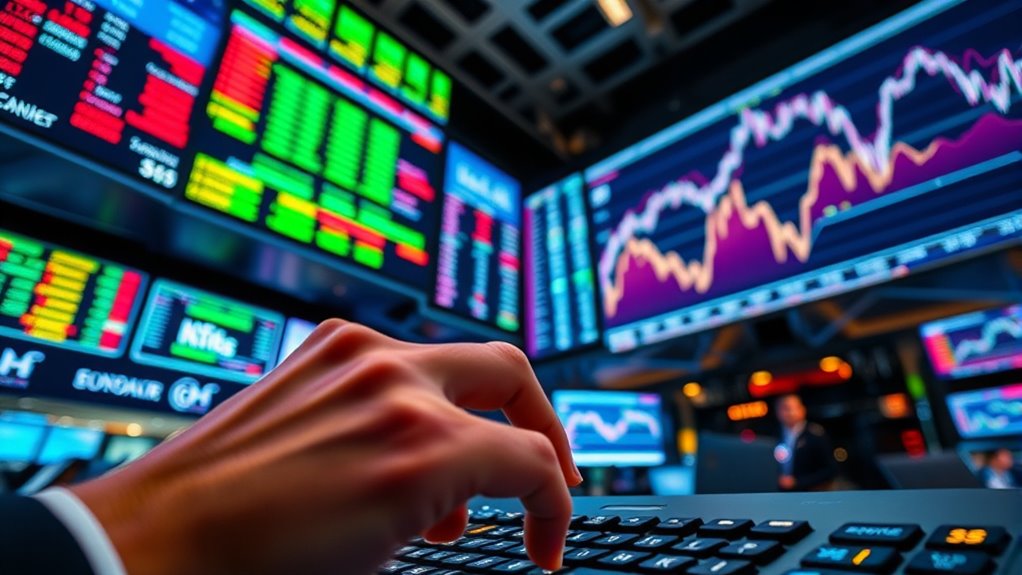ETF inflows show how much investor interest is building over time, indicating confidence in the market or specific assets. Spot volume measures actual trading activity in real time, revealing immediate liquidity and trader engagement. Typically, large inflows can lead to significant price moves, especially when paired with high spot volume. However, sometimes inflows happen without much trading, and vice versa. To understand how these factors influence market movements, keep exploring their interaction in different market scenarios.
Key Takeaways
- ETF inflows indicate investor confidence over time, while spot volume reflects immediate trading activity.
- Surges in ETF inflows can lead to price movements, especially when combined with high spot volume.
- Spot volume often reacts quickly to market news, signaling short-term momentum; ETF inflows show longer-term interest.
- Both metrics together provide a comprehensive view of market sentiment and potential price direction.
- High ETF inflows with low spot volume may suggest passive investing, whereas high spot volume indicates active trading influence.

When analyzing market trends, understanding the relationship between ETF inflows and spot volume is essential. These two metrics often tell different stories about investor behavior and market direction. ETF inflows, which reflect the amount of money flowing into exchange-traded funds, indicate investor confidence or concern about specific sectors or assets. When inflows increase, it generally signals bullish market sentiment, as investors are willing to put more capital into these products. Conversely, outflows can signal waning confidence or shifting market dynamics. Spot volume, on the other hand, measures the actual trading activity of the underlying assets—how much of the asset changes hands in a given period. Spot volume is often seen as a more immediate indicator of market interest and liquidity, revealing how actively traders are engaging with the asset itself.
Understanding ETF inflows and spot volume reveals investor confidence and market activity dynamics.
The relationship between ETF inflows and spot volume isn’t always straightforward. Sometimes, a surge in ETF inflows coincides with high spot volume, suggesting that investors are actively buying or selling the underlying assets. This can cause notable price movements, especially if the inflows are driven by institutional investors or large-scale trading strategies. However, there are instances where ETF inflows increase but spot volume remains subdued. This may happen when investors buy ETFs for long-term holding rather than active trading, or when market sentiment is cautious, prompting investors to prefer passive exposure over aggressive trades.
Market sentiment plays a vital role in how these two indicators interact. During bullish periods, positive market sentiment tends to attract more ETF inflows, which can, in turn, boost spot volume as traders react to the rising prices and increased activity. Conversely, during bearish phases, ETF outflows often grow, and spot volume might decline as traders become more hesitant. Regulatory impacts can considerably influence this dynamic, too. Changes in rules governing ETFs—such as restrictions on certain asset classes or increased transparency requirements—can either encourage or deter inflows. Regulatory uncertainty might suppress ETF inflows even if market sentiment remains positive, as investors seek safer or more transparent vehicles. Alternatively, clear and supportive regulations can boost inflows, leading to more active trading and higher spot volume. Additionally, the color accuracy of the underlying assets can influence trading behaviors, as clearer and more vibrant representations often attract more interest.
In essence, tracking ETF inflows alongside spot volume provides a clearer picture of market momentum. Recognizing how market sentiment and regulatory impacts influence these metrics helps you anticipate potential price movements. While ETF inflows signal investor interest over a longer horizon, spot volume captures the immediate trading activity and liquidity. Together, they reveal whether the market is driven by sustained confidence or short-term trading excitement, helping you make more informed decisions in a complex financial landscape.
Frequently Asked Questions
How Do ETF Inflows Impact Traditional Stock Markets?
ETF inflows influence traditional stock markets by shaping market sentiment and investor behavior. When inflows increase, they signal confidence, often boosting stock prices as investors seek exposure to popular funds. Conversely, outflows can trigger negative sentiment, leading to declines. Your understanding of these movements helps you anticipate market trends, recognizing that significant ETF inflows usually reflect optimism, which can drive broader market gains, while outflows may signal caution or uncertainty.
Can Spot Volume Predict Future ETF Inflows?
Spot volume can be a useful indicator for ETF inflow prediction. When you notice rising spot volume, it suggests increased trading activity and investor interest, which often precedes higher ETF inflows. By monitoring spot volume trends, you can better anticipate future ETF inflows, as heightened trading activity reflects market sentiment and potential capital movement into ETFs. Keep an eye on these signals to inform your investment decisions effectively.
Which Market Indicators Best Correlate With ETF Movements?
You should focus on market sentiment and trading volume to understand ETF movements. When market sentiment is positive, it often leads to increased ETF inflows as investors feel confident. High trading volume signals strong investor interest, which can also drive ETF prices higher. By monitoring these indicators, you can better anticipate potential ETF movements and make more informed trading decisions.
Do ETF Inflows Affect Global Market Liquidity?
You might wonder if ETF inflows influence global market liquidity. They definitely impact liquidity dynamics by increasing available capital, which can boost trading activity and improve market sentiment. When inflows surge, you’ll notice heightened market liquidity, making it easier to buy or sell assets without affecting prices. Conversely, outflows can tighten liquidity, leading to more volatility. So, ETF inflows play a vital role in shaping overall market health and sentiment.
How Do Geopolitical Events Influence ETF and Spot Trading?
Geopolitical risks heavily influence your trading decisions, as they can swiftly change risk sentiment. When tensions rise, you might see increased volatility in both ETF and spot markets, prompting you to adjust your positions. These events often prompt a flight to safety, reducing risk appetite and impacting liquidity. You should stay alert to geopolitical developments, understanding that they can trigger rapid market movements and alter the flow of trading activity.
Conclusion
In the end, understanding whether ETF inflows or spot volume drives the market helps you make smarter trading decisions. While ETF inflows show institutional interest and can signal longer-term trends, spot volume reflects immediate buying and selling activity. Keep an eye on both, but remember, neither alone guarantees market direction. By analyzing how these indicators interact, you can better anticipate market movements and adjust your strategies accordingly.









